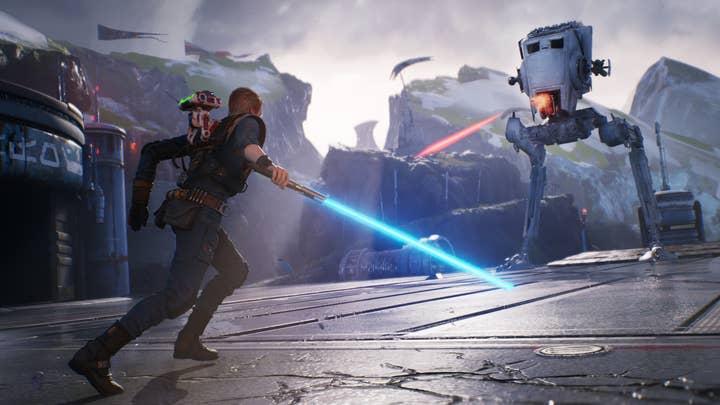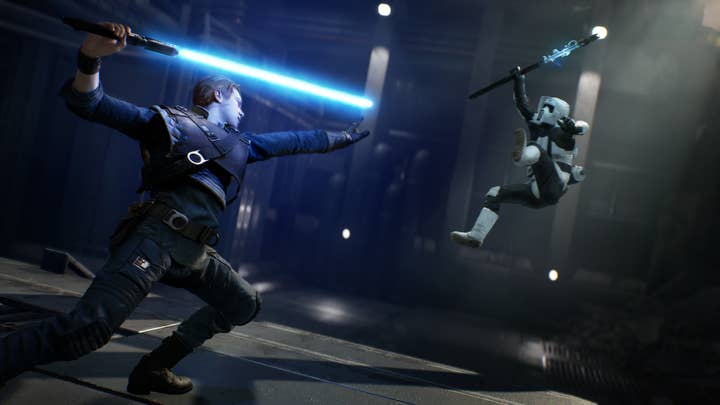Star Wars Jedi Fallen Order: Critical Consensus
Respawn Entertainment delivers on the experience of being a Jedi, critics say, but did the new film's imminent release cause EA to push the game out early?
The acquisition of Lucasfilm by Disney was supposed to provide the simplest possible answer to the question, "What do Star Wars fans want?" That answer -- in case the explosion in films, tv shows, theme park rides and lord knows what else hasn't made it abundantly clear -- was assumed to be, "more Star Wars."
As ever, reality has proved to be more nuanced than corporate optimism. Episode VII: The Force Awakens grossed more than $2 billion at the global box office, while Episode VIII: The Last Jedi squeaked past $1.3 billion -- still a lot of money, but the kind of decline that will moisten the palms of Disney executives. The most recent film release, Solo: A Star Wars Story, didn't even make it to $400 million, raising legitimate questions about whether the film managed to break even, and about the health of the Star Wars IP as a whole.
One of those questions is about how tolerant the Star Wars fanbase is to the very concept of the universe they love getting bigger. The Force Awakens was easily the biggest box-office hit of the new films, but it was also safe, familiar and utterly reverential of George Lucas' holy trilogy. The Last Jedi received stronger reviews -- an 85 Metacritic average compared to The Force Awakens' 81 -- but it was iconoclastic, causing a distressingly vocal minority to propose remaking the entire film. Star Wars fans, it seemed, didn't want to be challenged, and judging by the weak performance of Solo, their appetite in terms of volume simply didn't compare to something like the Marvel universe.
"The story itself is more than just a revenge fantasy. It's a meditation on trauma, loss, and what survivors owe the past"
Vice Waypoint
There is a legitimate question, then, about just how successful we can expect a Star Wars video game to be at this point in time. EA eventually made a success of Battlefront II after some early fumbles, but it could still rely on the game itself being, essentially, highly-polished fan service with little or no context or narrative logic required.
In attempting to tell a new story in the Star Wars universe, Respawn Entertainment is doing exactly what Disney imagined would be so successful when it spent $4 billion on Lucasfilm back in 2012. It is also doing the very thing that The Last Jedi and Solo have proved is no guarantee of a home-run, and in a medium where branded games have a mixed track record of success.
According to Vice Waypoint's Matthew Gault, Respawn's Star Wars Jedi: Fallen Order is at the very least a worthwhile addition to Star Wars lore. Set after the massacre of the Jedi at the end of the film Episode III: Revenge of the Sith, it follows trainee Jedi (okay, padawan) Cal Kestis as he attempts to reform the order to challenge the dominance of the Empire. It feels like a Star Wars story through and through, Gault points out, and it is executed with no expense spared.

"Story and style are two of Fallen Order's strengths," Gault explains. "The cast includes character actors Cameron Monaghan as Cal, Forest Whitaker reprising his role as morally compromised freedom fighter Saw Gerrera, and Tony Amendola as Jedi Eno Cordova. The London Symphony Orchestra performs the music and every story beat and musical cue hits just right. The story itself is more than just a revenge fantasy. It's a meditation on trauma, loss, and what survivors owe the past.
"Cal and his friends are survivors of both war and torture. These are characters defined by the pain of their past and Fallen Order explores those themes without flinching. The writing is superb and the story beats all land. This is a game, explicitly, about trauma and failure. The Jedi are destroyed. The Empire won. So what do the Jedi do now? Without the Order and its traditions, is Cal even really a Jedi?"
"By the end of the game, I have a huge range of options when it comes to messing up anyone who crosses me"
Polygon
While asking these weighty questions, Respawn has also delivered on the more whizz-bang elements of Star Wars -- specifically, the dynamics of lightsaber combat and the use of the Force to throw objects (and stormtroopers) about the place. Ben Kuchera of Polygon came to "despise the game for my first few hours," before eventually succumbing to the comforting sensation of eviscerating people with laser swords.
"As I gain skill points and unlock abilities that expand what Kestis is capable of, I begin to feel not only competent, but dangerous," says Kuchera. "I can lock onto a single enemy and circle them, waiting for them to attack so I can roll out of the way and counter. I can use the Force to push a stormtrooper, screaming, off a cliff. I can slow down their attacks and move into a better position. I can pull enemies toward me, and then throw them back at their friends to break up groups. I can deflect blaster bolts with my lightsaber in between direct attacks.
"Juggling various attacks with different lightsaber styles, while paying attention to the limited amount of Force energy I have, is challenging but doable. Simple button presses for attacks make sense tactically, while the actual in-game animations make everything look fluid and choreographed. I have options; how I choose to fight is up to me, and it changes depending on the situation and the number of enemies. And those enemies ratchet up in intensity, from local wild animals to stormtroopers to specially trained anti-Jedi forces and then ... well, I'd rather not spoil it.
Kuchera adds: "By the end of the game, I'm a killing machine, with a huge range of options when it comes to messing up anyone who crosses me."

This combination of story and sabres would be enough to get most console-owning Star Wars fans through the door, but Respawn has also paid attention to what they will be doing outside of moment-to-moment combat. The EA studio has adopted gameplay ideas from Dark Souls and Super Metroid to create a more distinctive structure to the gameplay, while -- as Wired's Julie Muncy points out -- the predominant traversal mechanics speak to the importance of exploration in the game's design.
"Each planet is a densely knotted level, a miniature open world with winding linear paths and significant side digressions that unravel only as you progress in player skill and character ability," Muncy says. "Much of the game is spent exploring, prodding at available paths and backtracking to brush past old dead ends with new abilities.
"In its rhythms, the game plays like one of the modern day Tomb Raider titles, with a dual interest in both exploration and storytelling"
Wired
"These quiet periods of exploration and puzzle solving are interspersed with periodic chunks of combat and scripted set pieces that lay familiar types of Star Wars bombast on thick -- exploding ships, giant alien creatures, lightsaber duels, and madcap chases. In its rhythms, the game plays like one of the modern day Tomb Raider titles, with a dual interest in both exploration and storytelling, but broader and more player-directed.
"Again, it's not groundbreaking, but it's well made from top to bottom. Each planet feels distinct and compelling, and the level design offers a satisfying loop of discovery and recognition as you discover new hidden areas and the paths that connect them to places you've already been."
For Eurogamer's Emma Kent, however, this emphasis on exploration and discovery of new areas in familiar spaces is "simultaneously the game's biggest asset, and biggest flaw -- a double-edged lightsaber, if you will." Early in the game, when the maps are smaller, traversing the same location with new abilities is satisfying, but as time ticks by and the world expands, Fallen Order's "Metroidvania elements become incredibly tedious."
"While you can unlock shortcuts, these are often hard to spot in the all-blue, complicated level maps, and are no longer marked in the bright yellow colour that indicates an unexplored area," says Kent. "In any case, most shortcuts aren't significant enough to make a big dent in travel time.
"With the buzz of exploring a new world now gone, you have a lot less patience to go back through complicated winding tunnels. Then, once you've completed your objective, the worst part of all: you have to trek back to the ship, a process which can take over 20 minutes of hacking your way through enemies you've already defeated. Even Dark Souls eventually gets a fast travel option about two-thirds of the way through, and Fallen Order is crying out for something similar."

Pacing is a complicated issue in video game criticism, and especially in games that offer significant opportunities to deviate from the main path of the story. One person's grind is another person's opportunity to wring every last level from a progression system, after all, so Fallen Order may not fall down at the hurdle that Eurogamer's Kent describes.
A more troubling issue from Respawn's point-of-view -- one mentioned by multiple esteemed outlets -- is an apparent abundance of technical issues with the version of the game provided to critics. In 2019, such problems tend to spawn memes and gifs that can genuinely damage a game's commercial performance. According to Giant Bomb's Brad Shoemaker, Fallen Order has far more than its fair share, from "fairly severe stuttering" when loading new areas, to "a multitude of minor bugs and unrefined elements too numerous to list."
In a review that is otherwise full of praise for the majority of what Respawn has set out to do, Shoemaker is left feeling that Fallen Order is "a game that impresses and frustrates in almost equal measure."
"To be clear, any one or two or even half a dozen of these quibbles wouldn't even be worth mentioning here, but they were pervasive enough to start chipping away at the experience I was having with what's otherwise a really enjoyable game, and they're particularly hard to ignore coming from companies as big as EA and Disney, and in a franchise as hallowed as Star Wars," Shoemaker says.
"As neither a game developer nor a member of Respawn I certainly can't pretend to know what led to the game shipping in this state, though the impending release of The Rise of Skywalker and the peak of the holiday shopping season are hard to ignore. My layman's impression is simply that the game would have benefited from a few more months in production. These problems can't be a surprise to anyone who made and tested this game, but of course time is what's required to actually fix them.
"That's what frustrates me about Jedi: Fallen Order: It's good enough that its host of technical problems feels like an affront to what the game could have been, and to the hard work and talent--and there's a considerable amount of talent here--of the people who made it."

